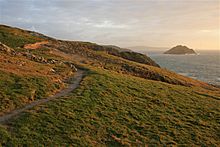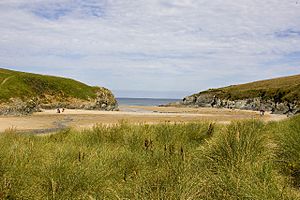Kelsey Head facts for kids
| Site of Special Scientific Interest | |

Kelsey Head from the coastal path
|
|
| Area of Search | Cornwall |
|---|---|
| Coordinates | 50°24′17″N 5°08′47″W / 50.4046°N 5.1464°W |
| Interest | Biological |
| Area | 227 hectares (2.27 km2; 0.876 sq mi) |
| Notification | 1951 |
Kelsey Head is a special place on the coast of north Cornwall, England. It's known as a Site of Special Scientific Interest (SSSI). This means it's a very important area for its plants and animals. Kelsey Head is also a headland, which is a piece of land that sticks out into the sea. This area is home to an ancient hill fort from the Iron Age.
Exploring Kelsey Head
Kelsey Head is a large area, about 227 hectares (that's like 560 football fields!). It was officially recognized as an SSSI in 1951. You can find it on the north coast of Cornwall, about 4 kilometers (2.5 miles) west of the town of Newquay.
The SSSI stretches from Holywell Beach in the west, near Holywell village. It goes all the way to Pentire Point West in the east, near West Pentire. The area also includes a beautiful little bay called Porth Joke. Plus, it covers inland spots like The Kelseys and Cubert Common.
A famous walking trail, the South West Coast Path, goes right through Kelsey Head. Most of the coastline here is looked after by the National Trust. They help protect special places like this for everyone to enjoy.
A Look Back in Time: History of Kelsey Head
Kelsey Head is a really old place with lots of history. It's home to the remains of an earthwork cliff castle. This castle was built during the Iron Age, a time long ago when people used iron tools. The castle was quite big, about 170 meters (550 feet) long and 160 meters (525 feet) wide.
But people lived here even before the Iron Age! Scientists have found small pieces of flint from the Mesolithic and Neolithic periods. These are even older times, showing that people have been using this land for thousands of years.
The cliff castle was protected by big earth and stone walls called ramparts. It also had a smaller extra area next to it. On the side facing inland, there was another earthwork and a ditch. These features helped protect the fort from invaders.
Amazing Wildlife and Nature
Kelsey Head has two main types of natural areas. One is the sand dunes at Holywell Bay. These are hills of sand shaped by the wind. The other is the calcareous grassland of Cubert Common. This is a special type of grassy area that grows on soil rich in lime.
But there are many other habitats too! You can find:
- Green meadows
- Scrubland with bushes and small trees
- Wet areas called wet flushes
- Small patches of woodland
- Tiny islands offshore
- And intertidal habitats along the coast. These are places between the high and low tide marks.
All these different habitats are perfect homes for many kinds of animals. You can find lots of invertebrate species here. Invertebrates are animals without backbones, like insects and crabs. Many colonies of seabirds also live and nest along the cliffs.


